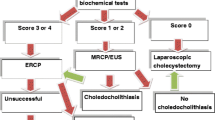Abstract
Background
Approximately 10% of patients with symptomatic gallstones may have associated common bile duct stones (CBDS). However, the predictive value of noninvasive tests as well as the properative diagnosis and management of CBDS have not been well defined. The aim of this study was to define an accurate and simple model for the prediction and management of CBDS.
Methods
A prospective database containing 986 cholecystectomies performed from 1994 through 1999 was evaluated. Univariate analysis using the Pearson chi-square test was performed to determine the factors significantly related to the presence of CBDS. Then logistic regression analysis was performed for multivariate analysis to discover independent predictors.
Results
Of the 986 patients in this study, 48 (5%) had CBDS. Of the 48 patients with choledocholithiasis, 22 (46%) were men and 26 (54%) were women. The mean age was 55.3 years (range, 16–87 years). As a result of multivariate analysis, abdominal ultrasonographic findings suggestive of CBDS (common bile duct diameter exceeding 8 mm or visible stones), total bilirubin, and gamma glutumyl transpeptidase levels above normal were the independent predictors of CBDS in patients age 70 or younger. On the other hand, an elevated bilirubin level was found to be the single independent factor related to CBDS in the elderly
Conclusions
For patients with gallstones, suggestive ultrasonographic findings in those younger than 71 years and elevated direct or total bilirubin level in those older than 70 years are the most valuable and practical predictors of CBDS, and thus are the proper indications for preoperative endoscopic retrograde cholangiography.
Similar content being viewed by others
References
Abbout PA, Malet PF, Berlin JA, Staroscik R, Cabana MD, Clarke JR, Shea JA, Schwartz JS, Williams SV (1996) Predictors of common bile duct stones prior to cholecystectomy: a meta-analysis. Gastrointest Endosc 44: 450–459
Alponat A, Kum CK, Rajnakova A, Koh BC, Goh PM (1997) Predictive factors for synchronous common bile duct stones in patients with cholelithiasis. Surg Endosc 11:928–932
Barkun AN, Barkun JS, Fried GM, Ghitulescu G, Steinmetz O, Pham J, Meakins JL, Goresky CA (1994) Useful predictors of bile duct stones in patients undergoing laparoscopic cholecystectomy. Ann Surg 220: 32–39
Cisek PL, Greaney GC (1994) The role of cholangiopancreatography with laparoscopic cholecystectomy in the management of choledocholithiasis. Am Surg 60: 772–776
Cuschieri A, Lezoche E, Morino M, Croce E, Lacy A, Toouli J, Faggioni A, Ribeiro VM, Jakimowicz J, Visa J, Hanna GB (1999) EAES multicenter prospective randomized trial comparing two-stage vs single-stage management of patients with gallstone disease and ductal calculi. Surg Endosc 13: 952–957
Demartines N, Eisner L, Schnabel K, Fried R, Zuber M, Harder F (2000) Evaluation of magnetic resonance cholangiography in the management of bile duct stones. Arch Surg 135: 148–152
Gallstones and laparoscopic cholecystectomy (1992) NIH Consensus Statement 10: 1–26.
Graham SM, Flowers JL, Scott TR, Bailey RW, Scowill VA, Zucker KA, Imbembo AL (1993) Laparoscopic cholecystectomy and common bile duct stones: the utility of planned perioperative endoscopic retrograde cholangiography and sphincterotomy: experience with 63 patients. Ann Surg 218: 61–67
Hauer-Jensen M, Karesen R, Nygaard K, Solheim K, Amlie E, Havig O, Viddal KO (1985) Predictive ability of choledocholithiasis indicators: a prospective evaluation. Ann Surg 202: 64–68
Heili MJ, Wintz NK, Fowler DL (1999) Choledocholithiasis: endoscopic versus laparoscopic management. Am Surg 65: 135–138
Korman J, Cosgrove J, Furman M, Nathan I, Cohen J (1996) The role of endoscopic cholangiopancreatography and cholangiography in the laparoscopic era. Ann Surg 223: 213–217
Leitman IM, Fisher LM, McKinley MJ, Rothman R, Ward RJ, Reiner DS, Tortolani AJ (1993) The evaluation and management of known or suspected stones of the common bile duct in the era of minimal access surgery. Surg Gynecol Obstet 176: 527–533
Liu C-L, Lo C-M, Fan S-T (1997) Acute biliary pancreatitis: diagnosis and management. World J Surg 21: 149–154
Onken JE, Brazer SE, Eisen GM, Williams DM, Bouras ER, DeLong ER, Long TT, Pancotto FS, Rhodes DL, Cotton PB (1996) Predicting the presence of choledocholithiasis in patients with symptomatic cholelithiasis. Am J Gastroenterol 91: 762–767
Prat F, Meduri B, Ducot B, Chiche R, Salimbeni-Bertolini R, Pelletier G (1999) Prediction of common bile duct stones by noninvasive tests. Ann Surg 229: 362–368
Roston AD, Jacobson IM (1997) Evaluation of the pattern of liver tests and yield of cholangiography in symptomatic choledocholithiasis: a prospective study. Gastrointest Endosc 45: 394–399
Sahai AV, Mauldin PD, Marsi V, Hawes RH, Hoffman BJ (1999) Bile duct stones and laparoscopic cholecystectomy: a decision analysis to assess the roles of intraoperative cholangiography, EUS, and ERCP. Gastrointest Endosc 49: 334–343
Santucci L, Natalini G, Sarpi L, Fiorucci S, Solinas A, Morelli A (1996) Selective endoscopic retrograde cholangiography and preoperative bile duct stone removal in patients scheduled for laparoscopic cholecystectomy: a prospective study. Am J Gastroenterol 91: 1326–1330
Tanaka M, Takahata S, Konomi H, Matsunaga H, Yokohata K, Takeda T, Utsunomiya N, Ikeda S (1998) Long-term consequence of endoscopic sphincterotomy for bile duct stones. Gastrointest Endosc 48: 465–469
Tham TCK, Lichtenstein DR, Vandervoort J, Wong RCK, Brooks D, Dam JV, Ruymann F, Farraye F, Carr-Locke DL (1998) Role of endoscopic cholangiopancreatography for suspected choledocholithiasis in patients undergoing laparoscopic cholecystectomy. Gastrointest Endosc 47: 50–56
Trondsen E, Edwin B, Reiertsen O, Faerden AE, Fagertun H, Rossalend AR (1998) Prediction of common bile duct stones prior to cholecystectomy: a prospective validation of a discriminant analysis function. Arch Surg 133: 162–166
Author information
Authors and Affiliations
Additional information
Online publication: 12 June 2001
Rights and permissions
About this article
Cite this article
Kama, N.A., Atili, M., Doganay, M. et al. Practical recommendations for the prediction and management of common bile duct stones in patients with gallstones. Surg Endosc 15, 942–945 (2001). https://doi.org/10.1007/s00464-001-0005-7
Received:
Accepted:
Issue Date:
DOI: https://doi.org/10.1007/s00464-001-0005-7




